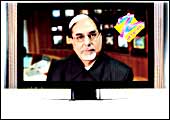 |
| The fatigue factor: Star's
Nair has to revive the leader's fortunes in key prime time
slots; Nair says he soon will |
 |
| Back in the reckoning: With
a mix of smart programming and marketing Zee is back at #2;
Chandra says the competition slipped too |
 |
| Cricket next: Despite Indian
Idol and Jassi, SET has lost out to Zee; Dasgupta, however,
believes the fight for #1 is between Sony and Zee |
In
the second week of September, ICICI Bank, one of India's top advertisers
(it spends around Rs 75-80 crore on television) signed an advertising
deal worth Rs 4.2 crore with Zee TV, the flagship channel of Zee
Telefilms. That number, Rs 4.2 crore doesn't look very significant
until it is compared with the bank's ad-spend on Zee last year,
Rs 45 lakh. That year, ICICI spent Rs 5 crore on star Plus, the
market leader in the general entertainment genre, and the flagship
of Rupert Murdoch's Indian empire. This year, says a media buyer,
it has pared its commitment to the channel to around Rs 2 crore.
ICICI Bank is not the only advertiser tuning
into Zee TV. According to Sunder Raman, Managing Director, Mindshare,
a media buying agency, "Many leading clients (GlaxoSmithKline,
Hero Honda and Pepsi, to name a few) have increased their spends
by around 100 per cent on Zee this year." "Zee TV had
been showing signs of a turn-around since late last year. Its
position has strengthened in the last six to eight weeks and its
gross rating points (GRPs) have almost doubled in comparison with
last year," he adds. The numbers bear him out.
According to Television Audience Measurement
(TAM) Media Research, the channel share of star Plus, Zee TV and
Sony Entertainment Television (SET) stood at 50.2 per cent, 20.2
per cent and 12.6 per cent in the January-September (2006) period
as against 55.5 per cent, 14.2 per cent and 16.4 per cent last
year, respectively. Clearly, Zee Telefilms, which became #3 in
a field of three in early 2003 has reclaimed its number two position
and according to Punit Goenka, Director, Zee Telefilms and the
elder son of Essel Group Chairman Subhash Chandra, "it will
soon be pitching for leadership".
That isn't just talk: until two months ago,
the list of the top 50 programmes, by viewership in cable and
satellite (C&S) households, read like a programme schedule
for star Plus (only rarely did Sony Entertainment Television or
Tamil channel Sun TV managed to break this monopoly with one,
maybe two entries). Today, Zee TV boasts 12 entries in the list,
although the first entry comes in at a none-too-impressive #19.
The Return Of The Prodigal
In many ways, the story of Zee, is one of
frittered opportunities. India's first C&S broadcast network
(it was launched in 1992) ruled the market till 1999. STAR entered
the country in 1991, but STAR Plus remained an English-only channel
because of a non-compete agreement with Zee with which it had
a joint venture; the JV was called off in 1998. It was only in
2000, with the launch of Kaun Banega Crorepati, the Hindi version
of Who Wants to be a Millionaire, however, that STAR Plus really
came into its own. Since then, the channel has garnered a viewership
base of 70-80 million and between 2000 and now, its marketshare
has ranged between 40 per cent and 55 per cent.
Sony Entertainment Television entered the
market in 1995, but its big break came in 2003 when it invested
$250 million (then Rs 1,150 crore) in securing the Indian subcontinent
television rights for all ICC cricket competitions (the World
Cup and the Champions Trophy) till 2007. It leveraged that to
good effect and became the clear #2 after STAR. STAR and SET have,
since then, invested in acquiring and producing content (STAR's
famous weepies and Sony's Jassi Jaisi Koi Nahin and Indian Idol,
the Indian version of American Idol), and on marketing and relegated
Zee to #3.
Zee tried a variety of things under several
CEOs (indeed, the fact that the company has served as a transit
point for several CEOs and senior managers continues to worry
some, as does the fact that the management continues to be dominated
by the promoting family) but to no avail. Since late last year,
however, it has made an inspired attempt to grab a fair share
of eyeballs, riding on the back of that fail-safe strategy: good
content. It reclaimed its #2 position from Sony late in 2005,
and is now trying to narrow STAR's lead. And the fact that it
now boasts a quarter of the programmes in the C&S Top 50 hasn't
gone unnoticed by advertisers.
That's helped the cause of revenues; advertising
still contributes around 70-80 per cent of the total revenues
in the broadcast business. "Ad rates on Zee TV have increased
from Rs 50,000-60,000 for a 10-second spot to Rs 70,000-100,000
in the last four to five months," says a media buyer with
a large agency. Comparative rates on STAR Plus are: Rs 1,00,000-1,25,000.
Zee TV's performance should boost the fortunes of the entire Zee
network; the general entertainment space still accounts for 34
per cent of the total C&S viewership and 39 per cent of the
total advertising spends on TV. Indeed, STAR India owes its numero
uno status to the performance of STAR Plus. The viewership of
other Zee channels, like Zee News, Zee Music, Zee Studio, Zee
Café and Zee Cinema has either been better or on a par
with comparable offerings from STAR. "Yet, it trailed behind
both STAR and SET because it could never get its act together
in the general entertainment space," says Farokh Balsara,
Industry Leader (Media and Entertainment Practice), Ernst &
Young India.
Is The Comeback For Real?
It is, insists Subhash Chandra, who claims
Zee lost out because it came out second best in the Zee TV vs
STAR Plus fight. "That happened because Zee TV had stopped
innovating on the programming and strategizing on the marketing
fronts." He adds, with a touch of irony: "Earlier, we
slipped because of our own failure, but this time, we are leading
partially because of our rivals' failure." Most media analysts
admit that STAR Plus and SET are showing some signs of fatigue.
"Except for the K-serials during 10-11 p.m. band (weepies,
invariably produced by Balaji Telefilms, all of whose names start
with K), other shows on STAR Plus have not really been able to
take off. Similarly, SET has also not been able to create any
excitement after Jassi... and Indian Idol," says Mindshare's
Raman.
PLAYING BIG BROTHER
Indian broadcast regulations are,
at best, a mess and, at worst, a manifestation of the government's
desire to control media. |
 |
 |
| Too much regulation: I&B
Minister Priya Ranjan Das Munshi and regulator Misra
have to let go |
India is one of the fastest growing
cable and satellite (C&S) TV markets in the world with
over 250 channels currently beaming into the country and 68
million C&S TV households (out of the total of 112 million
TV households). The total turnover of the industry is around
Rs 17,000 crore; of this, Rs 5,450 crore is on account of
advertising and Rs 10,000 crore is the estimated size of the
subscription market. Of this, only around 20-25 per cent reaches
broadcasters. "The Indian market has a great potential
in the sense that 48 per cent of households have no access
to TV yet," says Simon Twiston Davies, Chief Executive
Officer, Cable and Satellite Broadcasting Association of Asia
(CASBAA). Indeed, it is the lure of a virgin and a growing
market that has kept leading broadcasters committed to India.
"(Otherwise) lack of effective regulation could have
been a big distraction (for the broadcasters)," says
Davies. "Uneven regulation could impact competition and
the future investment, which, anyway, is too less in comparison
with other global markets," he adds.
Some of the inconsistencies that exist in the market include
the contradictions in the foreign direct investment levels
in the media and communications industry (49 per cent in
cable TV networks, 20 per cent in Direct-To-Home services,
26 per cent in news channels, 74 per cent in telecom networks
and 100 per cent in internet service providers); the inability
of the government and the industry to plug the leaks in
the subscription pipeline; and the regulated cable TV market.
"The DTH policy is also against free and fair competition
(there is a must provide clause which mandates all broadcasters
to make their channels available to all DTH service providers,
thereby, limiting their ability to distinguish their services),"
says Peter Mukerjea, Chief Executive Officer, STAR Group.
Then, some of the recent moves by the government and the
Telecom Regulatory Authority of India (TRAI), which also
regulates the broadcasting sector, threaten to throw things
entirely out of gear. TRAI, for instance, has mandated that
all pay channels be priced at Rs 5 in the areas that have
been notified for Conditional Access System (CAS), southern
areas of Delhi, Mumbai, Kolkata and Chennai. "Authorities,
obviously, haven't taken into account the cost of production
and acquisition for the players, which has consistently
risen at least 20-40 per cent every year in the recent past,"
says Kunal Dasgupta, CEO, Sony Entertainment Television.
And to add to the players' woes, the government is now planning
to bring in legislation that, according to the Ministry
of Information and Broadcasting, would help in regulating
the sector better. Some of the proposed moves in what is
called the Broadcasting Services Regulation Bill-2006 include
giving the government the power to suspend or revoke the
licences of players if it senses any threat to communal
harmony, state security or public interest, mandatory sharing
of certain sports broadcast signals, compulsory transmission
of public broadcaster's channels and limitations on cross-media
holdings.
Says G. Krishnan, CEO, TV Today: "The government's
move on regulating the broadcast industry is medieval in
nature. World-over, governments are moving away from regulation,
whereas in India, the government is trying to suffocate
the industry." "As far as, consumer interest is
concerned, nobody understands it better than the players
themselves," adds Mukerjea. The industry is hoping
that most of the provisions in the proposed Bill will be
watered down. "Otherwise, we will have no option but
to go to the courts," says a senior executive at a
leading broadcaster. Broadcasters have already done that
over TRAI's notification on channel pricing.
|
Zee's thrift-minded approach to programming-it
would invest only Rs 5-10 lakh per half hour of programming against
STAR's and SET's spends of around Rs 20-30 lakh; similarly, its
marketing and advertising spends were always 30-40 per cent less
than its rivals- is now changing. "Good programming and marketing
are the key to success and we are not going to make any compromises
here," says Goenka. Balaji Telefilm's new show on Zee TV,
Kasamh Se and another soap, Saath Phere, have helped Zee edge
out STAR Plus from the 9-10 p.m. prime time slot and the broadcaster
is now gearing up to claim the 8-9 p.m. slot.
Zee Telefilm's recent numbers, the results
for the first quarter of 2006-07, show the effects of this turnaround.
Revenues have grown 24 per cent; advertising revenues, 31.5 per
cent and while ebitda (earnings before interest, tax, depreciation
and amortisation) has declined by 13 per cent, analysts argue
that this is because of big money (around $219.15 million or Rs
1,030 crore) spent in acquiring global media rights for all cricket
matches played by India on neutral territory over the next five
years. Says Ankit Kedia, a media analyst with ICICI direct.com:
"Zee's efforts to improve its content and refurbish its image
are paying off. It has increased investment in programming by
almost 55-60 per cent and has launched a host of good shows."
Still, toppling STAR Plus won't be easy.
The channel still boasts a market share of 50 per cent as compared
to Zee TV's 20.2. "We have ruled the market for six years
and it is heartening to see someone give us competition now,"
says Sameer Nair, Chief Executive Officer, STAR Entertainment
India. Nair points out that some of STAR Plus' and STAR One's
recent programming initiatives didn't take off as expected but
he argues that the channels will soon get their rhythm back. STAR
Plus, in fact, has already started taking some remedial action.
While its K-serials in the 10-11 p.m. slot are still going strong
(delivering ratings between 8 and 12), it is revamping its other
prime time line-up. 'We will reclaim our lost slots soon,"
says Nair.
SET, too, is getting its act together. The
ICC Champions Trophy kicks off next month and the World Cup is
scheduled for 2007. "One would expect Rs 650-700 crore to
be spent on cricket advertising next year and a major chunk of
it is likely to go to the World Cup," says Sam Balsara, Chairman
and Managing Director, Madison, a media buying house. SET has
also acquired the India rights for Big Brother, an extremely popular
reality show in the UK, and according to Chief Executive Officer
Kunal Dasgupta, SET will launch "quite a few exciting shows"
in the next few months. "The fight for the leadership in
the market will soon be between SET and Zee," he claims.
Whoever be the rival, Zee will have to be
on its toes lest it loses the opportunity to reclaim its lost
ground the second time.
|









